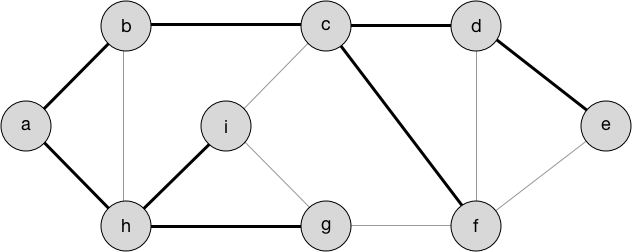Minimum Spanning Tree (Unweighted Graph)
A minimum spanning tree describes a path that contains the smallest number of edges that are needed to visit every node in the graph.
Take a look at the following graph:
If we start from node a and want to visit every other node, then what is the most efficient path to do that? We can calculate this with the minimum spanning tree algorithm.
Here is the minimum spanning tree for the graph. It is represented by the bold edges:
Drawn as a more conventional tree it looks like this:
To calculate the minimum spanning tree on an unweighted graph, we can use the breadth-first search algorithm. Breadth-first search starts at a source node and traverses the graph by exploring the immediate neighbor nodes first, before moving to the next level neighbors. If we tweak this algorithm by selectively removing edges, then it can convert the graph into the minimum spanning tree.
Let's step through the example. We start with the source node a, add it to a queue and mark it as visited.
queue.enqueue(a)
a.visited = trueThe queue is now [ a ]. As is usual with breadth-first search, we dequeue the node at the front of the queue, a, and enqueue its immediate neighbor nodes b and h. We mark them as visited too.
queue.dequeue() // a
queue.enqueue(b)
b.visited = true
queue.enqueue(h)
h.visited = trueThe queue is now [ b, h ]. Dequeue b and enqueue the neighbor node c. Mark it as visited. Remove the edge from b to h because h has already been visited.
queue.dequeue() // b
queue.enqueue(c)
c.visited = true
b.removeEdgeTo(h)The queue is now [ h, c ]. Dequeue h and enqueue the neighbor nodes g and i, and mark them as visited.
queue.dequeue() // h
queue.enqueue(g)
g.visited = true
queue.enqueue(i)
i.visited = trueThe queue is now [ c, g, i ]. Dequeue c and enqueue the neighbor nodes d and f, and mark them as visited. Remove the edge between c and i because i has already been visited.
queue.dequeue() // c
queue.enqueue(d)
d.visited = true
queue.enqueue(f)
f.visited = true
c.removeEdgeTo(i)The queue is now [ g, i, d, f ]. Dequeue g. All of its neighbors have been discovered already, so there is nothing to enqueue. Remove the edges from g to f, as well as g to i, because f and i have already been discovered.
queue.dequeue() // g
g.removeEdgeTo(f)
g.removeEdgeTo(i)The queue is now [ i, d, f ]. Dequeue i. Nothing else to do for this node.
queue.dequeue() // iThe queue is now [ d, f ]. Dequeue d and enqueue the neighbor node e. Mark it as visited. Remove the edge from d to f because f has already been visited.
queue.dequeue() // d
queue.enqueue(e)
e.visited = true
d.removeEdgeTo(f)The queue is now [ f, e ]. Dequeue f. Remove the edge between f and e because e has already been visited.
queue.dequeue() // f
f.removeEdgeTo(e)The queue is now [ e ]. Dequeue e.
queue.dequeue() // eThe queue is empty, which means the minimum spanning tree has been computed.
Here's the code:
func breadthFirstSearchMinimumSpanningTree(graph: Graph, source: Node) -> Graph {
let minimumSpanningTree = graph.duplicate()
var queue = Queue<Node>()
let sourceInMinimumSpanningTree = minimumSpanningTree.findNodeWithLabel(source.label)
queue.enqueue(sourceInMinimumSpanningTree)
sourceInMinimumSpanningTree.visited = true
while let current = queue.dequeue() {
for edge in current.neighbors {
let neighborNode = edge.neighbor
if !neighborNode.visited {
neighborNode.visited = true
queue.enqueue(neighborNode)
} else {
current.remove(edge)
}
}
}
return minimumSpanningTree
}This function returns a new Graph object that describes just the minimum spanning tree. In the figure, that would be the graph containing just the bold edges.
Put this code in a playground and test it like so:
let graph = Graph()
let nodeA = graph.addNode("a")
let nodeB = graph.addNode("b")
let nodeC = graph.addNode("c")
let nodeD = graph.addNode("d")
let nodeE = graph.addNode("e")
let nodeF = graph.addNode("f")
let nodeG = graph.addNode("g")
let nodeH = graph.addNode("h")
let nodeI = graph.addNode("i")
graph.addEdge(nodeA, neighbor: nodeB)
graph.addEdge(nodeA, neighbor: nodeH)
graph.addEdge(nodeB, neighbor: nodeA)
graph.addEdge(nodeB, neighbor: nodeC)
graph.addEdge(nodeB, neighbor: nodeH)
graph.addEdge(nodeC, neighbor: nodeB)
graph.addEdge(nodeC, neighbor: nodeD)
graph.addEdge(nodeC, neighbor: nodeF)
graph.addEdge(nodeC, neighbor: nodeI)
graph.addEdge(nodeD, neighbor: nodeC)
graph.addEdge(nodeD, neighbor: nodeE)
graph.addEdge(nodeD, neighbor: nodeF)
graph.addEdge(nodeE, neighbor: nodeD)
graph.addEdge(nodeE, neighbor: nodeF)
graph.addEdge(nodeF, neighbor: nodeC)
graph.addEdge(nodeF, neighbor: nodeD)
graph.addEdge(nodeF, neighbor: nodeE)
graph.addEdge(nodeF, neighbor: nodeG)
graph.addEdge(nodeG, neighbor: nodeF)
graph.addEdge(nodeG, neighbor: nodeH)
graph.addEdge(nodeG, neighbor: nodeI)
graph.addEdge(nodeH, neighbor: nodeA)
graph.addEdge(nodeH, neighbor: nodeB)
graph.addEdge(nodeH, neighbor: nodeG)
graph.addEdge(nodeH, neighbor: nodeI)
graph.addEdge(nodeI, neighbor: nodeC)
graph.addEdge(nodeI, neighbor: nodeG)
graph.addEdge(nodeI, neighbor: nodeH)
let minimumSpanningTree = breadthFirstSearchMinimumSpanningTree(graph, source: nodeA)
print(minimumSpanningTree) // [node: a edges: ["b", "h"]]
// [node: b edges: ["c"]]
// [node: c edges: ["d", "f"]]
// [node: d edges: ["e"]]
// [node: h edges: ["g", "i"]]Note: On an unweighed graph, any spanning tree is always a minimal spanning tree. This means you can also use a depth-first search to find the minimum spanning tree.
Written by Chris Pilcher and Matthijs Hollemans


